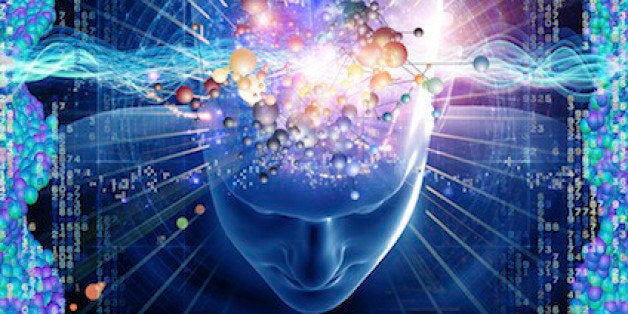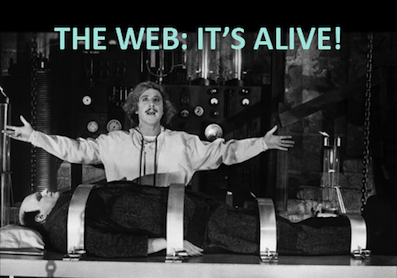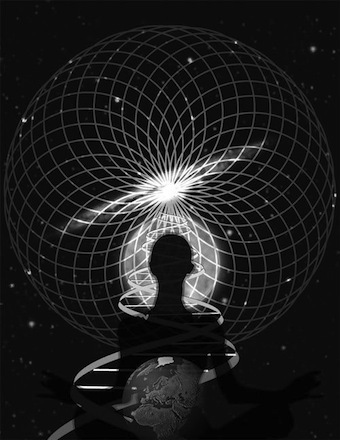
"Science is not only compatible with spirituality; it is a profound source of spirituality" -Carl Sagan
It appears that we are approaching a unique time in the history of man and science where empirical measures and deductive reasoning can actually inform us spiritually. Integrated Information Theory (IIT)--put forth by neuroscientists Giulio Tononi and Christof Koch--is a new framework that describes a way to experimentally measure the extent to which a system is conscious.
As such, it has the potential to answer questions that once seemed impossible, like "which is more conscious, a bat or a beetle?" Furthermore, the theory posits that any system that processes and integrates information, be it organic or inorganic, experiences the world subjectively to some degree. Plants, smartphones, the Internet--even protons--are all examples of such systems. The result is a cosmos composed of a sentient fabric. But before getting into the bizarreness of all that, let's talk a little about how we got to this point.
The decline and demise of the mystical
As more of the natural world is described objectively and empirically, belief in the existence of anything that defies current scientific explanation is fading at a faster rate than ever before. The majority of college-educated individuals no longer accept the supernatural and magical accounts of physical processes given by religious holy books. Nor do they believe in the actuality of mystical realms beyond life that offer eternal bliss or infinite punishment for the "souls" of righteous or evil men.
This is because modern science has achieved impeccable performance when it comes to explaining phenomena previously thought to be unexplainable. In this day and age, we have complete scientific descriptions of virtually everything. We understand what gives rise to vacuous black holes and their spacetime geometries. We know how new species of life can evolve and the statistical rules that govern such processes. We even have a pretty good understanding of the exact moment in which the universe, and thus of all reality, came into existence! But no serious and informed scientist will tell you that at present we fully understand the thing each of us knows best. That is, our own consciousness.
One of science's last greatest mysteries
Although we've come along way since the time of Descartes, who postulated that consciousness was actually some immaterial spirit not subject to physical law, we still don't have a complete and satisfactory account of the science underlying experience. We simply don't know how to quantify it. And if we can't do that, how do we know whether those non-human life forms that are unable to communicate with us are also conscious? Does it feel like anything to be a cat? Most will probably agree that it does, but how about a ladybug? If so, how can we know which life forms are more conscious than others? Do animals that show impressively intelligent behavior and elaborate memory, like dolphins or crows, experience the world in a unified conscious fashion as we do? These questions are almost impossible to answer without a way to measure consciousness. Fortunately, a neuroscientific theory that has been gaining popular acceptance aims to do just that.
Integrated Information Theory to the Rescue
Integrated Information Theory (IIT), which has become quite a hot topic in contemporary neuroscience, claims to provide a precise way to measure consciousness and express the phenomenon in purely mathematical terms. The theory was put forth by psychiatrist and neuroscientist Giulio Tononi, and has attracted some highly regarded names in the science community. One such name is Christof Koch, Chief Scientific Officer at the Allen Institute for Brain Science, who now champions the idea along with Tononi. Koch may be best-known for bringing consciousness research into the mainstream of neuroscience through his long-term collaboration with the late DNA co-discoverer Francis Crick. Now Tononi and Koch are actively researching the theory along with an increasing number of scientists, some from outside the field of neuroscience like esteemed physicist and popular author Max Tegmark, who is joining the ranks of those who believe they've figured out how to reduce one of science's greatest secrets to numbers. Bits of information to be exact.
Okay, so we now know that the theory is kind of a big deal to notable scientists. But how exactly does IIT attempt to quantify something as ill-defined and seemingly elusive as consciousness?
IIT in a nutshell
Just like a computer, the brain stores and processes information. But it is how that information is shared throughout the brain network that gives rise to our rich and vivid conscious experience. Let's consider the act of observing a sunset. Thanks to advances in brain imaging, modern neuroscience tells us that there are a number of different and distinct regions active during this event, each of which process information about different features of that event separately. There's a region in the visual cortex (known as "V2") that processes the form and color of the yellow and orange sunrays against the clouds. There are auditory areas in the temporal lobe being fed information about the sound of the wind rushing past you as you stare off into the horizon. That rushing wind against your skin also generates patterns of electrical signals in the somatosensory cortex that create a sense of touch. There are many different things going on in distant places.
Yet somehow we perceive it all as one unified conscious experience.
According to IIT, this unified experience relies on the brain's ability to fuse together (or integrate) all that incoming sensory information as a whole. To measure the degree of integration, Tononi has taken mathematical principles formulated by American engineer Claude Shannon, who developed a scientific theory of information midway through the 20th century to describe data transmission, and applied them to the brain. IIT claims that these information measures allow one to calculate an exact number that represents the degree of integrated information that exists in a brain at any given moment. Tononi chooses to call this metric "Phi" (or Φ), which serves as an index for consciousness. The greater the Phi, the more conscious the system. It need not matter whether it's the nervous system of a child, or a cat, or even a ladybug.
Problem solved?
Sounds simple and straight forward enough, doesn't it? Isn't this what science has strived to do all along? To describe things objectively and strip away all mystery from foggily understood natural phenomena? Could this be the solution to demystifying consciousness, the thing philosophers have been battling over for centuries? It may certainly answer some very important questions, but when you follow the theory to its logical conclusions things get pretty weird, and also, well, kind of neat. But before we get to the weird conclusions let's start with the weird questions, which have essentially been ignored by modern physical science, and at first ponder may even seem unremarkable.
Some hard questions
How can physical processing create inner, subjective experience?
How can matter possess first person perspective?
How can mere electrical signals produce qualitative sensation and awareness?
Why should information "feel" like anything in the first place?
These questions are functionally synonymous and define what philosophers have dubbed the "hard problem of consciousness," a concept that many neuroscientists have embraced. Conversely, the "easy problem" (although it is also extremely difficult) is figuring out all the computational and cognitive mechanisms underlying consciousness, which is categorically different than describing experience. Previously, science has only concentrated on solving those questions related to the "easy problem of consciousness." Some still believe that questions about subjective experience can't be answered quantitatively, and are therefore only appropriate topics for philosophy. Others handle the situation by refusing to acknowledge the existence of consciousness altogether! However, the truth of consciousness is self-evident, and denying it is equivalent to denying one's own existence. IIT is unique in that it recognizes consciousness as a real phenomenon that can be described objectively and mathematically.
But does IIT really address the "hard problem of consciousness," i.e., how subjective experience arises from the physical?
The answer is not quite.
The brain stores and processes information, but how and why that information takes on the characteristic of "feeling like something" is left unexplained. IIT tells us how to measure the degree of consciousness (Phi or Φ), but does not tell us how different types of information acquire different subjective sensations, like the feel of a burning flame or an orgasm. As stated by philosopher Ned Block, it may be that Phi is correlated with consciousness, but does not play a role in its cause.
So how do proponents of Integrated Information Theory attempt to explain subjective experience?
Christof Koch's answer: Consciousness is a fundamental property of the universe. Wherever there is integrated information, there is experience. The theory takes its existence as a given and therefore doesn't have to explain the mechanism behind it. It's just a fact of nature that information has an inner side in addition to its bit-composed outer side.
Let's follow the logic of this idea and see how it holds up. We know that certain brain states feel like something. Brain states are just information states. Therefore, information feels like something. Sounds pretty solid. Under IIT, lower mammals like cats have conscious experience, as do insects, even if only to some miniscule degree. Such an idea would seem intuitive. Why should there be some magical point at which a nervous system spontaneously turns conscious, like a switch had been suddenly flipped? It is more likely that a continuum of experience exists along a gradient, going from the very simple, raw sensations of single celled organisms to the more complex qualitative awareness of the human-sort. But what about non-biological systems that integrate information?
Things start to get weird
What's interesting about IIT is that it doesn't require that a conscious entity be a living organism. Any system that can integrate information, whether it be carbon-based or composed of silicon chips and metal wires, should produce conscious states. As information processors, modern computers possess some amount of experience, but presumably so little that it may be undetectable by human observers. In fact, according to IIT, it actually feels like something to be your iPhone. This should please artificial intelligence researchers who often long for their creations to someday be "alive". In our technology driven world, IIT says that consciousness is both in our homes and in our hands.
Although all of this may seem pretty strange, the idea that machines can be conscious might not be entirely unfathomable, especially given the amount of science fiction that has instilled visions of self-aware robots into our psyche. Is this as far as the theory goes?
Nope.
If you are very clever (or perhaps very high) then upon reading the above you may have briefly considered the following question in some form or another. Aren't humans always exchanging information through a global network of interconnected computers that collectively store and integrate information in some complex fashion? Let's follow IIT down the rabbit hole.
The Internet wakes up
If we are to take IIT seriously, we must accept that a system such as the Internet can possess conscious states like that of a biological nervous system, as so long as information is being integrated in a similar fashion. This possibility has been explored by Christof Koch himself:
"Consider humankind's largest and most complex artifact, the Internet. It consists of billions of computers linked together using optical fibers and copper cables that rapidly instantiate specific connections using ultrafast communication protocols. Each of these processors in turn is made out of a few billion transistors. Taken as a whole, the Internet has perhaps 10^19 transistors, about the number of synapses in the brains of 10,000 people. Thus, its sheer number of components exceeds that of any one human brain. Whether or not the Internet today feels like something to itself is completely speculative. Still, it is certainly conceivable."
However, at the current time it seems highly unlikely that the Internet possesses the level of first-person experience as do you or I. Our brains have been shaped by evolution over millions of years in ways that have developed and refined its information processing capabilities. But still, the potential for a self-aware World Wide Web is surely there.
An information-based collective consciousness
That's right. The theory allows for the emergence of an abstract "superorganism" that is composed of many individual organisms. Many puzzling questions are to follow. If the web were to "wake up" so to speak, would it exhibit apparent forms of observable unified and coordinated behavior? Or would we simply be an unknowing unit in a larger system in the same way a neuron is unaware of its contribution to a mental state? It's not only fun to entertain the idea of a living entity that would possess essentially all the knowledge accumulated by humanity, but also scientifically productive.
In theory, there's almost no limit to how large a fully conscious system can grow and evolve in space. It is bound only by the rate of information and complexity growth, which we have seen tends to increase exponentially.
So far we've discussed consciousness that can span large distances with no palpable physical structure. But what about arrangements of information that are too small for the eye to see?
Protons that feel
IIT says that anything with a non-zero Phi has subjective experience. This includes subatomic particles. Koch writes:
"Even simple matter has a modicum of Φ [integrated information]. Protons and neutrons consist of a triad of quarks that are never observed in isolation. They constitute an infinitesimal integrated system."
This has profound consequences. It would mean that consciousness is spread throughout space like a cosmic web of experience. Of course awareness is greatest where there is significant information integration, but in essence, "mind" (or "psyche") is everywhere. IIT turns out to be a modern twist on an ancient philosophical view known as "panpsychism". But before you go dismissing the concept because of its name, you should know that intellectual heavy hitters such as Baruch Spinoza, Gottfried Leibniz, and William James are all considered panpsychists. Its central tenant is that all matter has a mental aspect, which makes consciousness universal. Koch goes on:
"The entire cosmos is suffused with sentience. We are surrounded and immersed in consciousness; it is in the air we breathe, the soil we tread on, the bacteria that colonize our intestines, and the brain that enables us to think."
A new spirituality constrained by science
So far Integrated Information Theory is the best candidate for a scientific doctrine that provides an objective description of consciousness. As such, it deserves that we consider the possibility of such seemingly radical ideas. Pondering questions previously deemed appropriate only for pot smoking college dorm-dwellers is now a task for the best and brightest scientific minds. Most rational thinkers will agree that the idea of a personal god who gets angry when we masturbate and routinely disrupts the laws of physics upon prayer is utterly ridiculous. This theory doesn't give credence to anything of the sort. It simply reveals an underlying harmony in nature, and a sweeping mental presence that isn't confined to biological systems. IIT's inevitable logical conclusions and philosophical implications are both elegant and precise. What it yields is a new kind of scientific spirituality that paints a picture of a soulful existence that even the most diehard materialist or devout atheist can unashamedly get behind.
"The religion of the future will be a cosmic religion. It should transcend personal God and avoid dogma and theology. Covering both the natural and the spiritual, it should be based on a religious sense arising from the experience of all things natural and spiritual as a meaningful unity." -Albert Einstein


